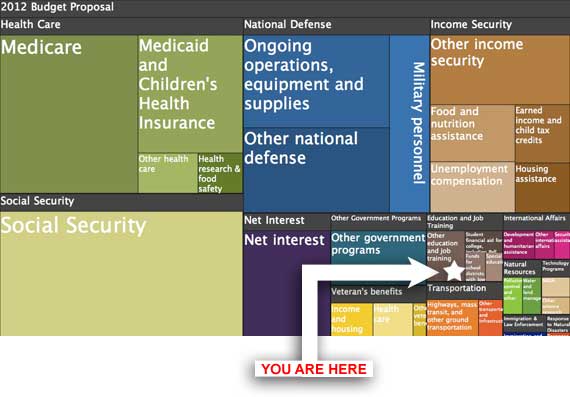Policy & Funding | News
Ed Tech Consolidated in 2012 Federal Budget Proposal
The Obama administration formally released its 2012 federal budget proposal Monday, dissolving a number of education programs into broader funding pools--including state grants for education technology previously provided for under Enhancing Education Through Technology (EETT).
Ed Tech Consolidation
The 2012 budget isn't the first from the the Obama administration that has proposed consolidating ed tech grants into larger "authorities." As with the 2011 proposal, the administration's 2012 budget proposal merges EETT funding into an authority called "Effective Teaching and Learning for a Complete Education." In 2012 budget, that overall category is budgeted at $835.5 million, less than in the 2011 proposal ($1.02 billion) but more than what has been allocated to that category via fiscal 2011 continuing resolution ($819.9 million).
As with last year's Presidential budget proposal, there is no specific line item for education technology in the 2012 proposal. Rather, the Obama administration has suggested in multiple publications that funding for technology is implicit within the broader categories outlined in the budget proposal. For example, in supplemental information issued by the United States Department of Education with regard to consolidation, there's a parenthetical note that states, "Note: Each program would include a focus on educational technology."
Nevertheless, that consolidation doesn't sit well with some. Doug Levin, executive director of the State Educational Technology Director's Association (SETDA), one of the major ed tech advocacy groups, characterized the shift in funding as a direct threat to technology funding, regardless of the vague intent to integrate technology as a part of overall spending.
"The Administration budget request is thin on details for their technology integration/consolidation strategy," he told us via e-mail. "Technology has long been an allowable funding stream under many federal education programs, so it is difficult to see the difference between consolidation and elimination."

A graphical breakdown of the Obama administration's fiscal year 2012 budget, provided by whitehouse.gov (locator added). |
Levin said that while there are some positives about the 2012 proposal--such as ed tech investments for special education--those positives can't substitute for for explicit funding for broad education technology funding. "For all practical purposes, there is no difference in what the administration proposed in FY11 [versus] FY12. For FY12, we're pleased to see the continued and new educational technology investments for special education students, for research, and for data systems and data use. However," he said "this doesn't obviate the need for continued investment in an educational technology infrastructure for all--and corresponding professional development and technology support--able to support the successful implementation of the common core standards, next generation assessments, online and blended learning, and other efforts to prepare all students for college and 21st century careers."
He continued: "Sustained and predictable educational technology investments are foundational to the education reforms the nation needs--just as bridges and highways have been for commerce. We look forward to continuing to work with Congress and the administration to ensure that no school, teacher, [or] student--urban or rural--is denied the opportunity for a world-class education because in 2011 we didn't have the vision or will to do so."
Breaking Down ETaLfaCE
In the budget proposal, the Effective Teaching and Learning for a Complete Education authority is broken down into three smaller categories:
- Effective Teaching and Learning: Literacy ($383.3 million), which includes Striving Readers, Even Start, Literacy Through School Libraries, National Writing Project, Reading Is Fundamental, and Ready-To-Learn Television;
- Effective Teaching and Learning: STEM ($206 million), which includes just one program--Mathematics and Science Partnerships; and
- Effective Teaching and Learning for a Well-Rounded Education ($246.1 million), which includes Excellence in Economic Education, Teaching American History, Arts in Education, Foreign Language Assistance, Academics for American History and Civics, Close Up Fellowships, and Civic Education.
The first and second authorities would provide competitive grants to state education agencies (by themselves or to agencies partnering with third parties, such as "nonprofit organizations and institutions of higher education") to support literacy and STEM initiatives. The last would provide competitive grants to local agencies to "develop and expand innovative practices to improve teaching and learning in the arts, health education, physical education, foreign languages, civics and government, history, geography, environmental education, economics and financial literacy, and other subjects," according to a budget summary provided by ED.
In addition, that document indicated, funds would be reserved, in part, to "strengthen the use of technology across the core academic content areas." (This last aligns with the "National Activities" category proposed in the Obama administration's Elementary and Secondary Education Act reauthorization blueprint.
The complete Obama 2012 budget proposal can be accessed here.
What About FY 2011?
Though President Obama has released his fiscal year 2012 budget proposal, FY 2011 is still a significant issue. The federal government has been operating via continuing resolution, and the current resolution is set to expire in just three weeks. Further, there's some contention over cuts that have been proposed for the current fiscal year, including the elimination of EETT. "This past Friday, the House appropriations committee proposed dramatic cuts to the remainder of the FY11 education budget. These cuts would eliminate over 50 education programs--including EETT--as well as dramatically cut nearly a dozen others," said Doug Levin, executive director of the State Educational Technology Directors Association. "The full House of Representatives will still need to approve this proposal and then come to some agreement with the Senate. At this point, the House and Senate feel far apart and it is not inconceivable that we could see a federal government shutdown as a result." |